
|
|

November 20, 2009
Tijuana and Rosarito Beach, Baja California, Mexico
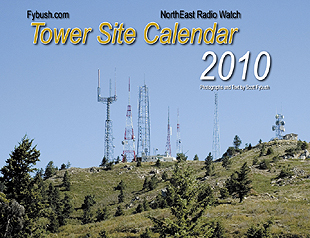 (portions originally
published Feb. 27, 2009)
(portions originally
published Feb. 27, 2009)
Welcome to our new season of Tower Site of the Week - and the latest in a series of TSoTW installments showcasing the images you'll find in the brand-new Tower Site Calendar 2010, arriving any day now in a mailbox near you - especially now that we're caught up on a shipping backlog.
(It's more than just pretty pictures and dates - the modest sum we raise from each year's calendar helps make possible the travel needed to make this feature happen every week on the website...and we're grateful for all your support!)
This week's installment picks up at the tail end of an April, 2008 visit to Tijuana, Mexico - and while the main purpose of the visit was to visit the transmitter site of XETV and its quasi-sister station, XEWT-TV (chronicled in depth here and here), our day south of the border included a jaunt to the beach, where we shot the picture of border blaster XEWW 690 (formerly XETRA) that graces one page of the new Tower Site Calendar.
So join us as we pick up our coverage, already in progress, as we head out of the gated compound that's home to Channels 6 and 12...
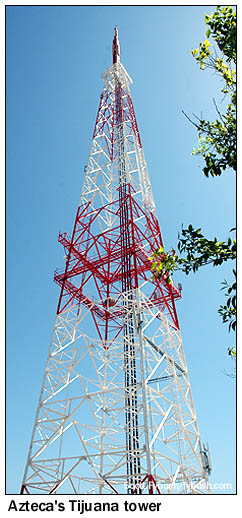
|
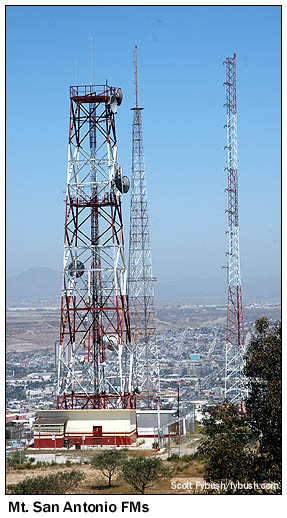
|
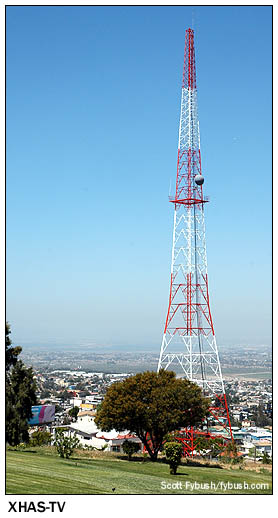
|
Before we headed down from the mountain for a delicious lunch at the Tijuana Brewery just downhill from the station, we took a moment to take in the view from Mount San Antonio, which includes several other tower sites.
To the east of the Televisa compound, another self-supporting tower belongs to the other major TV group in Tijuana, Televisa's archrival TV Azteca. They have two stations in town: XHTIT (analog 21/digital 29), relaying Azteca's "Canal 7" from Mexico City, and XHJK (analog 27/digital 28), relaying Azteca's "Canal 13," and I believe there's a small studio somewhere in Tijuana for local news inserts to some of the national network programming.
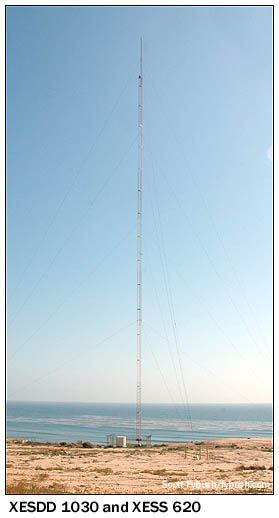 Another
TV station, Telemundo's XHAS (analog 33), has its tower and studio
facility on the road that leads up to Televisa's compound, right
across the street from the big "canal 12" sign advertising
Televisa's XEWT. Although it's licensed in Mexico, XHAS appears
to aim most of its programming (especially local news) at the
cross-border audience in the U.S.; it, unlike XEWT, is seen on
cable as far north as San Diego's North County area.
Another
TV station, Telemundo's XHAS (analog 33), has its tower and studio
facility on the road that leads up to Televisa's compound, right
across the street from the big "canal 12" sign advertising
Televisa's XEWT. Although it's licensed in Mexico, XHAS appears
to aim most of its programming (especially local news) at the
cross-border audience in the U.S.; it, unlike XEWT, is seen on
cable as far north as San Diego's North County area.
There's FM up on Mount San Antonio, too, but it's not entirely clear to me which station is where. Looking out from the XEWT patio, there's a cluster of towers (shown above) that I believe contains XETRA-FM (91.1) and XHITZ (90.3); both stations are now operated by Finest City Communications, the San Diego broadcaster that took over most of the Mexican signals that had been controlled by Clear Channel.
A third ex-Clear Channel signal, XHOCL (99.3), may also be up here somewhere; it was doing oldies as "Cool 99.3" for a while, but is now "La Mejor," part of an unusual simulcast with XHTIM (97.7) that has both stations running the same programming, but with ad content aimed at San Diego on 99.3 and at Tijuana on 97.7.
And with that, we say farewell to Mount San Antonio and, after lunch, to Tijuana proper, heading south down Highway 1 through the hills that separate Tijuana from the coast - and specifically from Rosarito Beach, the resort town along the Pacific coast that attracts bargain-loving retirees from San Diego and points north.
For many decades, it's also attracted AM broadcasters seeking to beam their signals north over the border to not only San Diego but to Los Angeles, 100 miles beyond - and on this sunny April day in 2008, it's attracting a car full of radio geeks out to see some of the towers that broadcast the signals we've all heard many times from the U.S. side of the border.
We start our tour south of Rosarito, where an exit off the coastal toll highway puts us right by the fence surrounding one of the newest of the Rosarito sites. This single tower carries XESS (620) and XESDD (1030), both the descendants of signals that were originally licensed to Ensenada, 30 miles or so down the coast, and as we gaze out past it to the ocean, we recall the fight a few years ago when this area suddenly sprouted signals on other frequencies, too, including one on 560 that wreaked havoc with U.S.-licensed stations such as KLAC 570 in Los Angeles and KBLU 560 in Yuma, Arizona. The 560 eventually moved to 1700, while XESS moved from 780 to 620 and XESDD from 920 to 1030, but there's still doubt about whether some of the other new signals - including these two - are using the parameters that Mexican officials reported to the FCC. (At one time, XESDD was supposedly using a slant-wire directional feed to this tower, but there's no evidence of that in these pictures that we can see.)
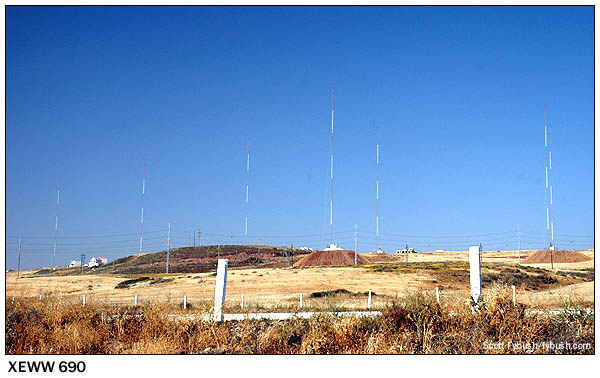 Not
far from the XESDD/XESS site, we come to a much more venerable
station, albeit with a fairly brief history at this location.
Not
far from the XESDD/XESS site, we come to a much more venerable
station, albeit with a fairly brief history at this location.
We're still south of Rosarito by a few kilometers, but we're now looking east, with our backs to the ocean, as we survey the seven-tower array that went up a few years back for what was then XETRA (690).
XETRA, of course, was the old Gordon McLendon station, originally XEAK before he reinvented it, circa 1960, as an all-news station "in the air, everywhere over Los Angeles" - even though the newsreaders were in the transmitter shack in Mexico.
That old transmitter shack was north of Rosarito, in close proximity to two more sites we'll see presently, and it remained there through XETRA's other incarnations in the years after McLendon, doing beautiful music, then AC, then oldies, then sports (originating the "XTRA Sports" branding that lives on in San Diego), and in its final years - now under Clear Channel - as standards "Fabulous 690."
Along the way, 690 traded its old 50,000-watt facility north of Rosarito for this new seven-tower site down the coast, pumping out 77.5 kW by day and 50 kW at night, pretty much all of it aimed north at California.
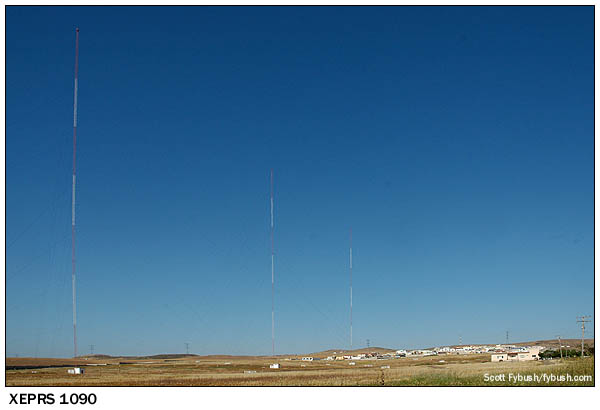 When
Clear Channel divested its Mexican interests in 2006, 690 ended
up as a simulcast of the "W Radio" network based at
XEW (900) in Mexico City, and not long before our visit, it changed
calls from XETRA to XEWW to reflect its new Spanish-language
affiliation.
When
Clear Channel divested its Mexican interests in 2006, 690 ended
up as a simulcast of the "W Radio" network based at
XEW (900) in Mexico City, and not long before our visit, it changed
calls from XETRA to XEWW to reflect its new Spanish-language
affiliation.
With our time in Mexico running short, we now turn north on the toll road, heading back toward San Diego - but with three more sites still on our agenda before we're off to the border.
The first site we see as we head north is just off one of the highway exits, where three towers spread off to the east, where a low-slung transmitter building sits.
This was the station where the Wolfman howled, the old XERB (1090), and I'm pretty certain it was these very towers that carried his 50,000 watts north to the ears of all those listeners in the Southland.
XERB went urban, then Spanish in the seventies as XEPRS - but it returned to English-language programming a few years back, doing sports as "Double X Sports Radio" with programming that included (and still includes) the San Diego Padres.
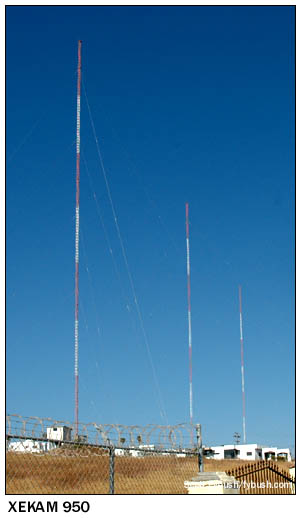
|
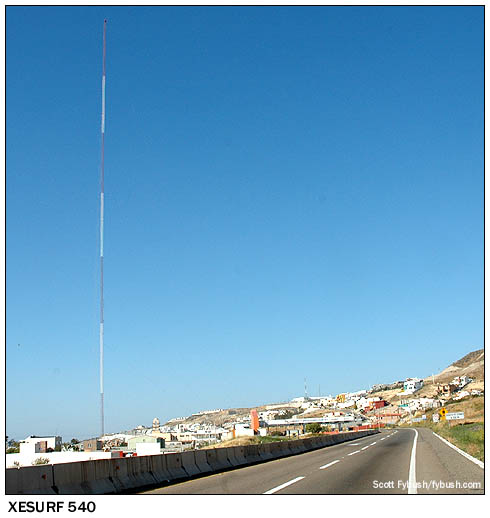
|
Two more sites complete our ride north along the coast: just north of XEPRS, there's another three-tower array belonging to XEKAM (950), with a Spanish talk "Radio Formula" format and running 20 kW days, 5 kW at night, again aimed north into San Diego. And just before we stop at the last toll barrier before the road turns east toward Tijuana and the border crossing, we see a site that wasn't there the last time we traveled this road a few years ago: the tower of XESURF (540), Saul Levine's Los Angeles-based border blaster that simulcasts the talk format of his KGIL (1260 Beverly Hills).
- Previous Site of the Week: Janesville and Beloit, Wisconsin
- Next Week: KSTP, St. Paul, Minnesota
- Site of the Week INDEX!
- How can you help support Site of the Week? Click here!
- Submit your suggestions for a future Site of the Week!
